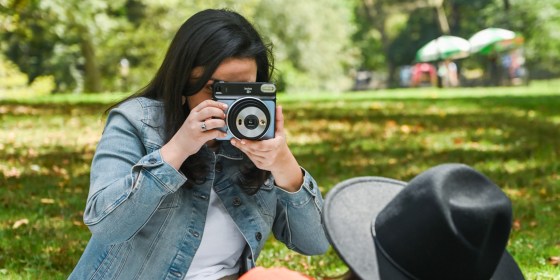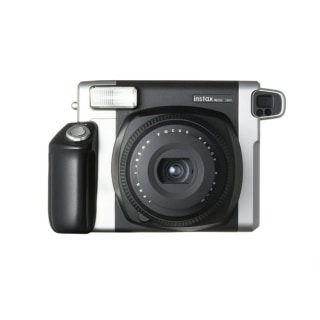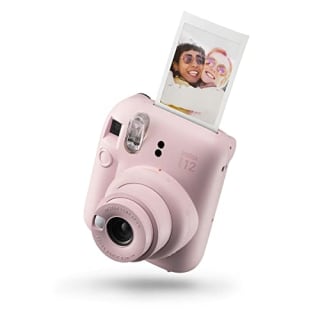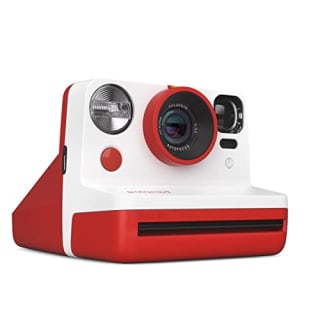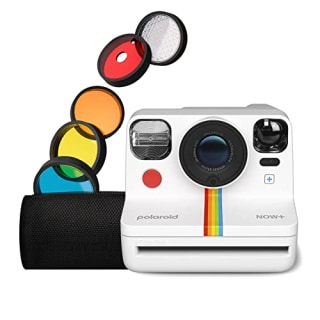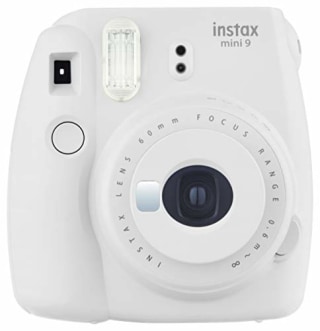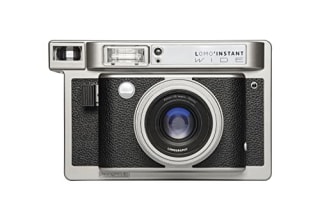Snapping pictures on your smartphone may be the easiest way to capture your special moments, but they lack the special touch that tangible photographs can provide.
On the other hand, developing photos and taking your film to a print shop can also be time-consuming. That’s where instant cameras come in — they can snap your sacred, special moments and immortalize them in print.
“There's a spontaneity to instant film,” says Andrew Tess, a New York-based photographer and artist. “It's incredible to capture and create something tangible in a physical sense — especially in this digital age we live in.”
We spoke with photography experts about the best instant camera options on the market and what to look for when shopping for one. Plus, we asked Select staffers for their top picks; I also tried several options, three of which made the final list.
SKIP AHEAD The best instant cameras | How to shop the best instant cameras
Our top picks
- Best overall/editor’s pick: Polaroid Now Generation 2
- Best splurge: Lomo’Instant Wide
- Most lightweight: Fujifilm Instax Mini 12 Camera
How we picked the best instant cameras
We spoke with experts about what to look for when shopping. Here is what we kept in mind:
Flash: Every instant camera on our list has a built-in flash for low-light conditions.
Battery: Most of the options on our list use AA batteries, which are sometimes included in the camera bundles.
Weight: Every model weighs less than 1.5 pounds, which is generally light enough to carry in your everyday bag, according to our experts.
The best instant cameras
To find the best options on the market, we consulted with three experts and included their recommendations, Select staff picks and my personal favorites.
Fujifilm Instax Wide 300 Instant Camera
Fujifilm’s Instax Wide 300 comes highly recommended by Yuxi Liu, a professional photographer, videographer and social media consultant who has owned this camera for over four years. “It delivers the widest and best quality photos compared to other cameras on the market,” he says. The camera’s wide film allows you to fit more in each shot, beneficial for group pictures or background pictures, according to our experts. It’s also a favorite of Select editorial projects associate, Rebecca Rodriguez. “Not only is this camera stylish, but I love that it uses wide instant film,” she says. “It’s also lightweight, which makes it easier to carry on my shoulder or throw in a tote.” The camera, which weighs 1.3 pounds, has a retractable 95mm lens, a close-up lens for portrait shots and auto flash and autofocus features, according to the brand. The camera also comes with four AA batteries — though, you’ll have to buy the film separately.
Weight: 1.3 pounds | Exposure control: Automatic | Flash: Built-in
Fujifilm Instax Mini 12 Camera
The Fujifilm Instax Mini 12 is my go-to instant camera. I love the quality of each printed photo, which I find surprisingly detailed and not overexposed — a pet peeve I have with other models I’ve tried. This colorful camera also has a built-in selfie mirror, automatic exposure and flash control. While I haven’t timed how long each picture took to develop, this camera ejects pictures almost immediately after I’ve snapped them. (Photos should then develop within 90 seconds, according to Fujifilm.) You’ll also get two included AA batteries to get you started.
Weight: 0.67 pounds | Exposure control: Automatic | Flash: Built-in
Polaroid Now Generation 2
Polaroid film is my favorite type of film due to its long-lasting quality — I have taken pictures three years ago that still look like they were just snapped on my camera. That’s why I also like the Polaroid Now, which I've been using for the past six months on my travels. The Now camera has an built-in flash, a self-timer and an option for double exposure. “Double exposure combines and layers two exposures on top of each other in one image, photographing the same frame twice,” says Edolia Stroud, a creative director and photographer from Brooklyn, New York. The end result is a layered image on the same frame, like a picture of flowers layered on top of concrete. I also really like the autofocus system, which makes it easy for a beginner like me to get decent shots without having to fiddle with the lens. The flash is manual too, so I can turn it on or off with the click of a button. It’s also compatible with multiple Polaroid films, including black and white and color options. The only downside? The film can take a few minutes to develop.
Weight: 1 pound | Exposure control: Double exposure available | Flash: Built-in
Polaroid Now+ Gen 2
If you want more control over how the final picture looks, consider the Polaroid Now+. The Now+ replaced the OneStep+, which is a favorite of Stroud. The Now+ uses two different types of film including 600 and iType options. (The main difference between the two is that iType film is built for newer Polaroid cameras. If you previously owned a Polaroid camera, you can repurpose 600 film for the Now+, according to the brand.) “I love how warm the colors and tones are and the ‘vintage look’ the photos give me,” says Stroud. The Now+ also connects to the Polaroid app and lets you customize the aperture, light, exposure and self-timer, for automatic shots. There are five lens filters too to further saturate or add contrast to your photos. If you're wondering why you should pick the Now+ over the Polaroid Now we recommend above, the Now+ works seamlessly with the Polaroid app and comes with extra lens filters. If you can live without the added customization the app provides, you can stick with the Polaroid Now.
Weight: 0.99 pounds | Exposure control: Double exposure available | Flash: Built-in
Fujifilm Instax Mini 9
The Instax Mini 9 is a slightly older version of the Instax Mini 12. It’s a favorite of Stroud’s, for its travel-sized build and picture quality. “The size of the film is about the same as a credit card and the colors of the photos are more of a cooler tone, compared to Polaroid cameras,” she says. Like other Fujifilm cameras on our list, this one also has a selfie mirror, flash and exposure settings. That said, while the Mini 9 will suggest an exposure setting, you’ll have to manually adjust the dial — the Instax 12 does this automatically. The 12 also has a built-in lens for close-up and selfie pictures, while the Mini 9 needs an additional lens attachment for the same. That said, it weighs less than a pound and only needs two AA batteries to get started.
Weight: 0.68 pounds | Exposure control: Manual (five settings) | Flash: Built-in
Lomo’Instant Wide
Lomography’s Instant Wide comes with three lens attachments: an ultra-wide, close up and splitzer lens option, which lets you layer images over each other. It also has auto exposure and aperture settings, for a narrow or deeper depth of field. I personally adore the retro look of this camera, and the added lens attachments, particularly the ultra-wide lens which lets me capture great background shots. Select reporter Harry Rabinowitz also likes the ability to shoot in landscape orientation, since most instant cameras usually have vertical orientation and are set to portrait mode. “The viewfinder is also surprisingly good for an instant camera,” he says. The flash control is manual too, so you can decide if you want to take advantage of it or not. It uses the same film as the Instax Mini 12, so if you already own that camera and are looking to upgrade, the Lomo’Instant Wide is a great camera to add to your collection.
Weight: N/A | Exposure control: Automatic | Flash: Built-in
How to shop for the best instant cameras
While shopping for the best instant cameras our experts recommend keeping the following in mind:
Flash: A built-in flash helps you photograph at night or in low-light conditions. “Flash is best used in low-light conditions, and when you need to capture close-ups,” says Stroud. Some cameras also come with flash control, which automatically adjusts how much flash your pictures need, depending on your environment. Other cameras have a manual flash, which you can turn on or off.
Selfie mirror: A selfie mirror is an added bonus if you like to take close-up pictures of yourself. I usually use them to adjust my pose or expression before I snap a picture — this way I waste less film.
Lighting features: Many instant cameras come with automatic settings, most commonly to adjust exposure, which determines how bright your picture is. “Exposure is the amount of light that reaches your camera’s sensor,” says Stroud. “Overexposure would lead to a bright highlighted photo and underexposure leads to darker tones and shadows.”
Shutter speed: This is how fast the shutter on the camera opens and closes, which exposes the sensor to light, according to Stroud. “A fast shutter creates a short exposure and a slow shutter creates a longer exposure allowing more light.” For example, if you’re trying to capture rapid movement, you’ll require a faster shutter speed, according to New York City-based photographer Natalie Jane. If you want to play with light dragging, or capture the stars, you would focus on keeping your shutter open as long as possible to let in all that light,” she says.
Meet our experts
At Select, we work with experts who have specialized knowledge and authority based on relevant training and/or experience. We also take steps to ensure all expert advice and recommendations are made independently and without undisclosed financial conflicts of interest.
Andrew Tess is New York-based photographer and artist who works with his camera to capture subjects ranging from NYC's Queer and underground circles to international celebrities.
Yuxi Liu is a New York-based photographer, videographer and social media consultant who has worked with brands including Shake Shack, Bacardi and luxury hotels around the world.
Edolia Stroud is a creative director and photographer from Brooklyn, New York. Her work has appeared in Italian Vogue.
Natalie Jane is a photographer based in New York City.
Why trust Select?
Nishka Dhawan is an associate editor at NBC Select. For this piece, she asked Select staffers for their favorite instant cameras, spoke to photographers and tried three instant cameras herself, to find the best ones.
Catch up on Select's in-depth coverage of personal finance, tech and tools, wellness and more, and follow us on Facebook, Instagram and Twitter to stay up to date.

